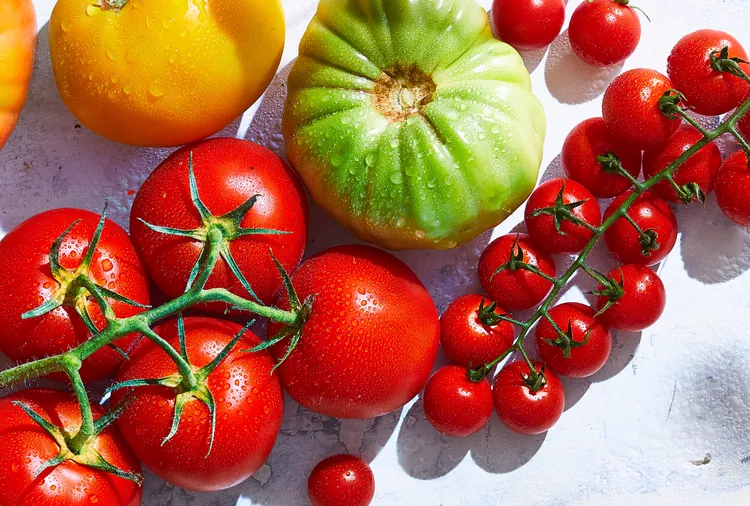This Trick for Storing Tomatoes Helps Keep Them Fresh for More Than a Week

The world of produce storage can get confusing. It’s like a game of tug of war between all the “dos” and “don’ts.” Don’t store these items in the freezer. Do keep these fruit and veggie foes apart—unless you want them to spoil faster. Don’t refrigerate a handful of produce picks, but do be sure to chill the majority.
So we totally understand why readers come to us often with questions about how to store tomatoes. We’ve already covered how to can tomatoes and how to freeze tomatoes, but in terms of fresh, to refrigerate or not to refrigerate? That is the question, and our Test Kitchen has the answers.
- Lynn Blanchard, Better Homes & Gardens Test Kitchen director
- Sarah Brekke, M.S., Better Homes & Gardens Test Kitchen brand manager
How to Store Tomatoes to Keep Them Fresh for as Long as Possible
The most important thing to keep in mind when considering how to store tomatoes: what state they’re in. Your best bet will vary based on whether the tomatoes are whole or cut.
How to Store Whole Tomatoes
Store tomatoes at room temperature until ripe, Blanchard advises. Although whole tomatoes might appear to be fresher longer when you store them in the refrigerator, looks can be deceiving.
“Refrigeration stops the ripening process,” Brekke says. “If the tomatoes were under-ripe going into the refrigerator, the taste and texture won't improve. There are certain enzymes in tomatoes that are responsible for creating that delicious flavor as they ripen, but these enzymes aren’t active at refrigerator temps.”
Depending on their starting state of ripeness, refrigerating tomatoes can lead to a mealy, mushy, or hard texture. It also compromises tomato flavor; resulting in flavorless or sour fruit.
To maximize the flavor, fresh factor, and lifespan of fresh tomatoes, store them at room temp (or in an ideal world, between 60° to 65° F) on a counter or in a cabinet away from sources of heat or direct light at room temperature.
“That said, if you have freshly picked or purchased ripe tomatoes and you don’t plan on eating them right away, they can be placed in the refrigerator for up to a couple of days to extend their life,” Brekke says. “For best flavor, let the tomatoes come to room temperature before serving.”
How to Store Unripe Tomatoes
If you happen to harvest or invest in tomatoes that are under-ripe, you’ll also want to store them at room temperature. As we hinted to earlier, “the cool temperatures in the refrigerator will halt the ripening process, and you will be left with a tomato that is pale, mealy, flavorless,” Brekke says.
Place unripe tomatoes in a single layer inside a paper bag (such as a grocery bag), and fold the bag to close it loosely. Why, you might be asking? The bag helps contain the ripeness-inducing ethylene gas tomatoes emit. Transfer the bag to a dry and warm room temperature spot, then check on the tomatoes daily to see how they’re progressing.
Test Kitchen Tip: To press “fast-forward” on tomato ripening, add a banana or apple inside the bag, too. Both of these fruits are also ethylene-producers. The more ethylene gas swirling around the tomatoes; the faster the ripening.
How to Store Cut Tomatoes
The one exception to the no refrigeration rule: cut tomatoes. After you’ve washed and sliced or diced your tomatoes, you must store them in the fridge to reduce the risk of bacteria growth.
Keep in mind that tomatoes spoil quicker once cut. Transfer sliced or diced tomatoes to an airtight food storage container, store them in the refrigerator, and aim to polish them off within 2 days.
The No. 1 Trick About How to Store Tomatoes to Keep Them Fresh and Flavorful Longer
Now that you know where to store tomatoes, let’s talk about exactly how to store tomatoes. Don’t forget that tomatoes—heirloom, Roma, cherry, grape, or otherwise—are fragile, so store them with care.
Beyond that, our Test Kitchen’s best storage secret: Flip the tomatoes upside down. Storing the tomatoes stem-side down “reduces the amount of airflow around the stem area therefore reducing contact with various mold and bacteria that can speed up the spoilage process,” Brekke says. This also helps the tomatoes retain moisture so they stay juicy longer, Blanchard adds.
To up the ante even more, use scotch tape to cover the stem, then flip the tomatoes stem-side down. Doing so should keep fresh tomatoes juicy yet firm and sweet for 7 to 10 days, depending on the starting ripeness of your tomatoes.
As for cherry or grape tomatoes, we recommend placing them in a shallow dish or basket so air can flow. These tomatoes tend to ripen quicker, so check in on them every day or two. Remove and compost any small tomatoes that are showing signs of spoilage to avoid it spreading to the rest.
When to Wash Tomatoes
As with most produce items, “we recommend washing tomatoes just before you are ready to use them,” Brekke says. “Moisture encourages mold, yeast, and bacterial growth.”
Wash tomatoes under cool running water, pat try, then slice or enjoy whole, depending on the fruit size and your specific tomato recipe.
How to Tell if Tomatoes Have Gone Bad
Speaking of spoilage, Brekke shares the signs to watch for to know it’s time to toss your tomatoes:
- Soft and mushy areas
- Broken skin
- Leaking juices
- Unpleasant aroma
- Mold